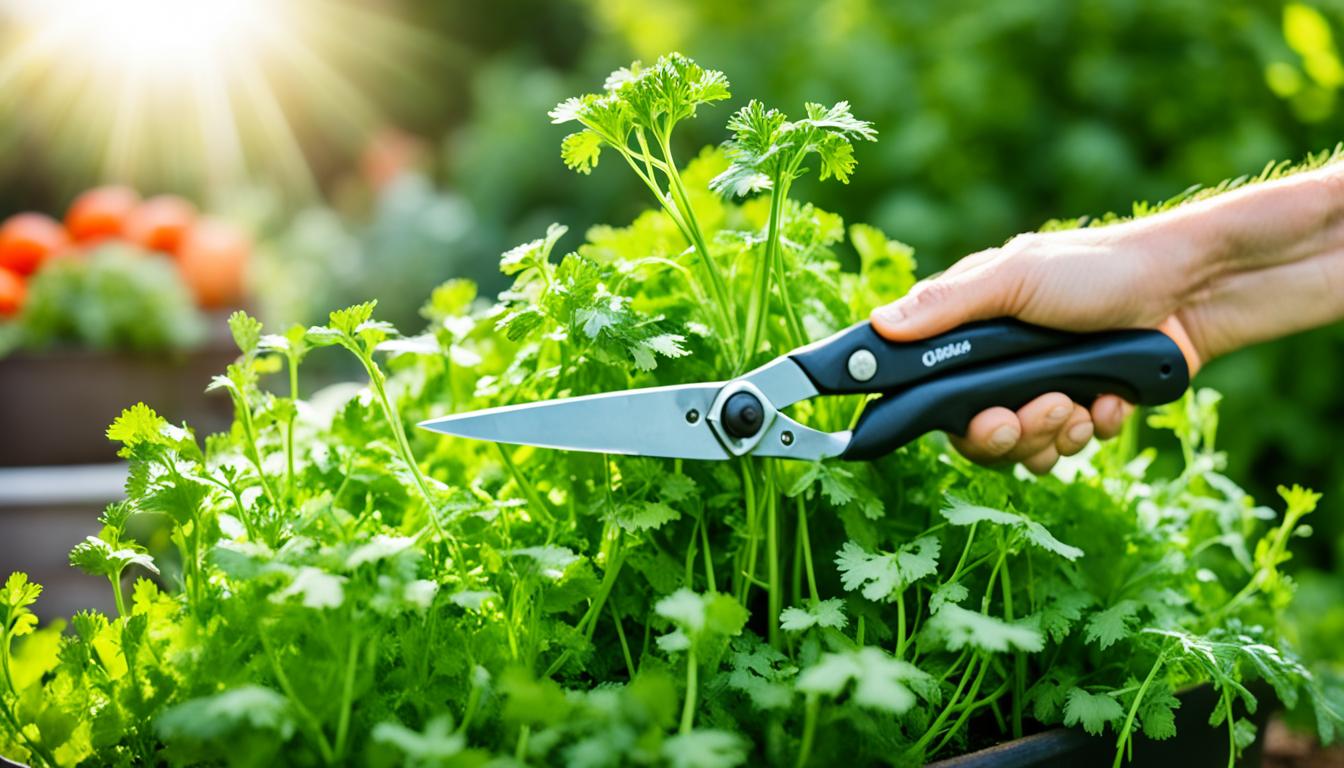I’ve learned the secret to making cilantro grow and keep producing all season. Cilantro loves the cool weather of spring and fall. With a few easy steps, you can keep your cilantro plants giving you fresh leaves for your cooking.
Cilantro does best in full sun and soil with a pH of 6.2 to 6.8. In the South and Southwest, plant cilantro in the fall or early spring, a month before the last frost. This lets the plants grow strong in the cooler months.
To keep cilantro coming, plant a new batch every 3 to 4 weeks, using seeds or Bonnie Plants® starter plants. This way, you’ll always have plenty of this tasty herb, even when it gets warmer in late spring.
Understanding Cilantro’s Life Cycle
Cilantro is a popular herb known for its unique taste. It is an annual plant that does well in cool to moderate weather. However, it struggles in the heat. Knowing how cilantro grows helps gardeners get the most out of it and enjoy its flavor all season.
Cilantro’s Short Growing Season
Cilantro grows fast, especially in spring. This quick growth can be good and bad for gardeners. It thrives in temperatures up to 65-70°F. But, when it gets hotter in late spring and early summer, cilantro starts to bolt. This means it quickly makes flowers and seeds, ending its useful life.
Signs of Bolting
Before cilantro bolts, you’ll see some signs. A tall, central stem and smaller, deeply lobed leaves appear. Also, the leaves may turn yellow as the plant focuses on making flowers and seeds.
Knowing about the cilantro life cycle, cilantro growing season, and signs of bolting helps gardeners plan better. This way, they can keep harvesting cilantro and enjoy its taste all season.
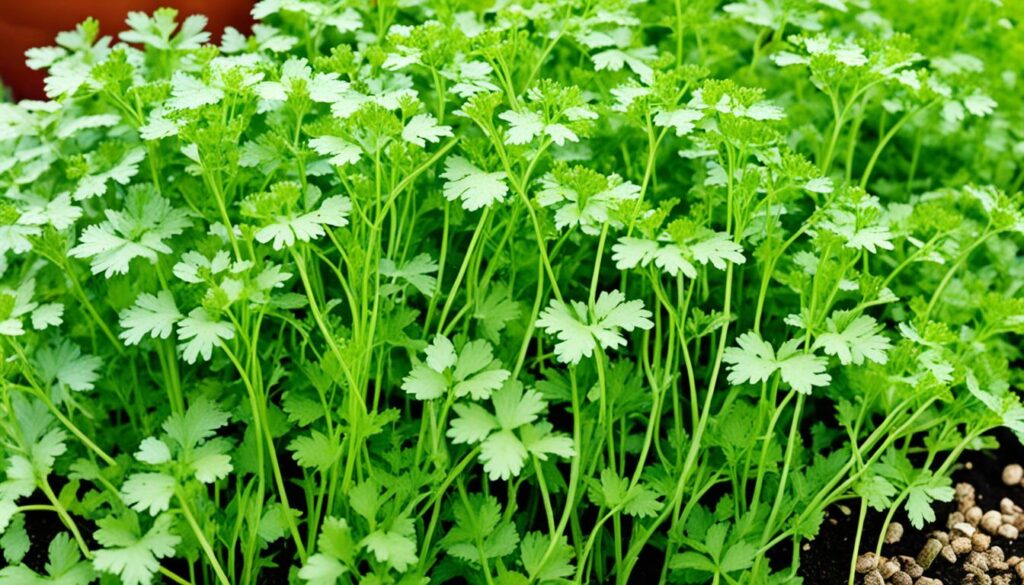
“Cilantro is a fast-growing herb that can be tricky to maintain, but with the right techniques, you can extend its harvest and enjoy its fresh, aromatic leaves throughout the season.”
Factors That Trigger Cilantro Bolting
Cilantro is a versatile herb that adds a unique flavor to many dishes. However, it can be challenging to grow because it tends to bolt or flower too early. Knowing what causes cilantro to bolt is key to keeping your crop healthy and productive.
Temperature and Photoperiod
Cilantro loves cool weather, doing best in temperatures between 65°F and 70°F. When it gets hotter than 75°F, it thinks it’s time to flower and bolt. The length of the day also matters. If daylight is over 12 hours, cilantro starts to focus on making seeds instead of leaves.
Stress and Environmental Conditions
Other things can make cilantro bolt too. Not enough water, sunlight, or nutrients stress the plant. This stress makes it want to reproduce quickly before it gets worse.
| Factor | Impact on Cilantro Bolting |
|---|---|
| Temperature | Bolting occurs when temperatures exceed 75°F (24°C) |
| Photoperiod | Cilantro bolts when day length exceeds 12 hours |
| Stress | Insufficient water, light, or nutrients can induce bolting |
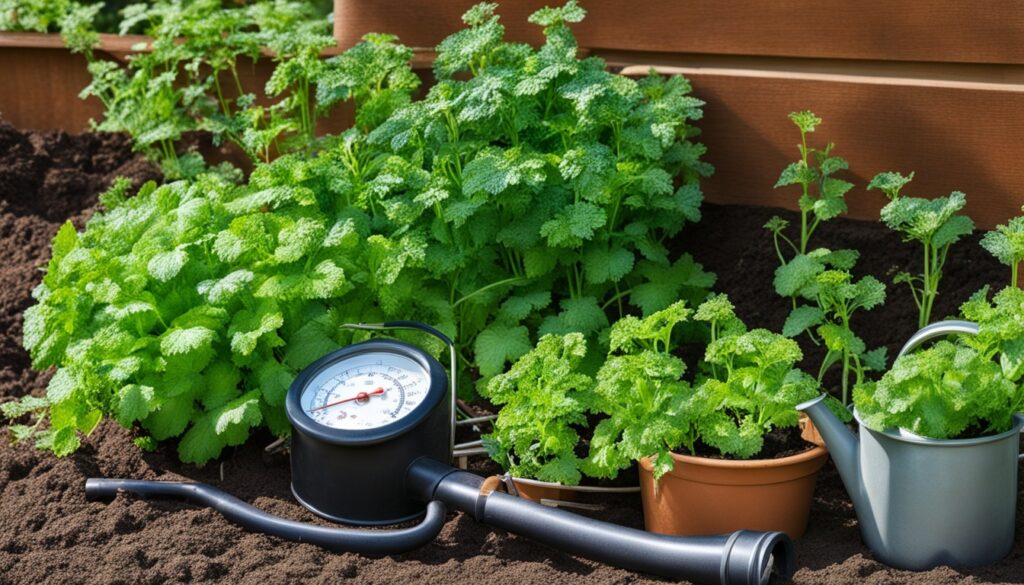
Understanding what makes cilantro bolt helps gardeners keep their plants healthy longer. By using strategies like planting more often, shading, and watering right, you can enjoy cilantro for a longer time.
How to Harvest Cilantro So It Keeps Growing
Harvesting cilantro the right way is crucial for a steady supply of this fragrant herb. By knowing when and how to pick, you can keep your cilantro plants thriving. This way, you’ll always have fresh cilantro for your dishes.
Timing and Frequency of Harvesting
Cilantro plants grow to about 6-8 inches in 4 weeks before they’re ready for their first cut. It takes around 120 days or 4 months for them to flower and produce seeds. Using the cut and come again method lets you harvest several times in the spring and early summer.
Proper Harvesting Techniques
To pick cilantro, cut the leafy stems close to the ground. Don’t take off more than one-third of the leaves at once. This keeps the plant healthy and encourages more growth. You can store fresh cilantro in the fridge, wrapped in damp towels in a sealed bag, for up to a week.
Or, you can freeze it in ice-cube trays with water. This keeps its flavor for up to 4 months.
By following these tips, you’ll have a steady supply of fresh cilantro all season. This will make your cooking even more delicious with the bright taste of this versatile herb.
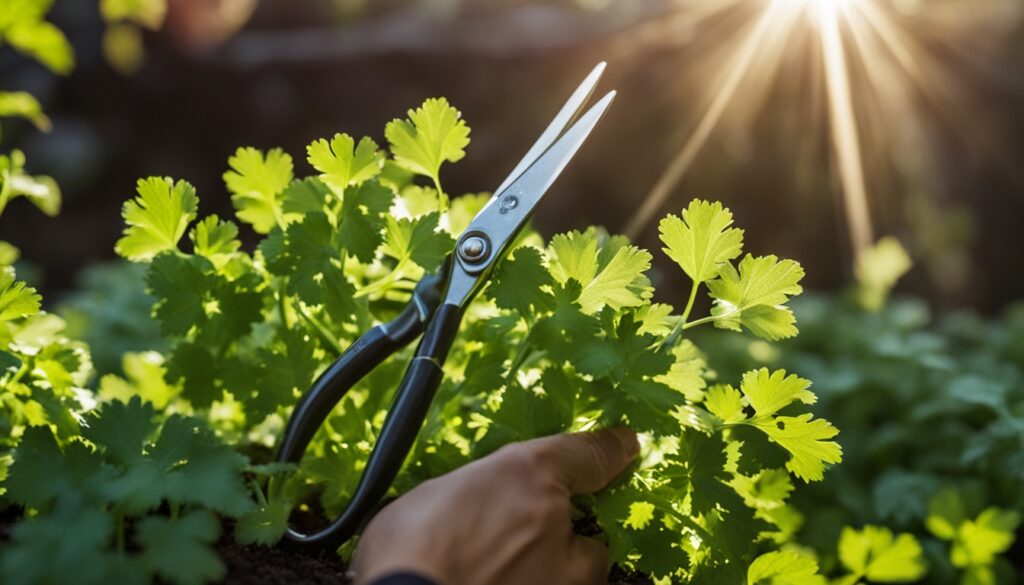
Extending the Cilantro Harvest
I’ve learned a few tricks to keep cilantro fresh all season. Succession planting and shading and mulching are my go-to methods.
Succession Planting
I plant new cilantro every 3 to 4 weeks in spring or before the first fall frost. This way, I always have cilantro ready to use. Cilantro grows fast, taking 30-50 days to mature. So, planting it in stages means I never run out.
Shading and Mulching
Shading and mulching also help keep cilantro fresh longer. A little shade or a shade cloth can stop it from flowering too soon. Plus, a thin layer of mulch keeps the roots cool in hot weather. These steps won’t stop cilantro from flowering completely, but they help.
With these tips, I can enjoy cilantro all season. It adds a fresh, herbal taste to many dishes.
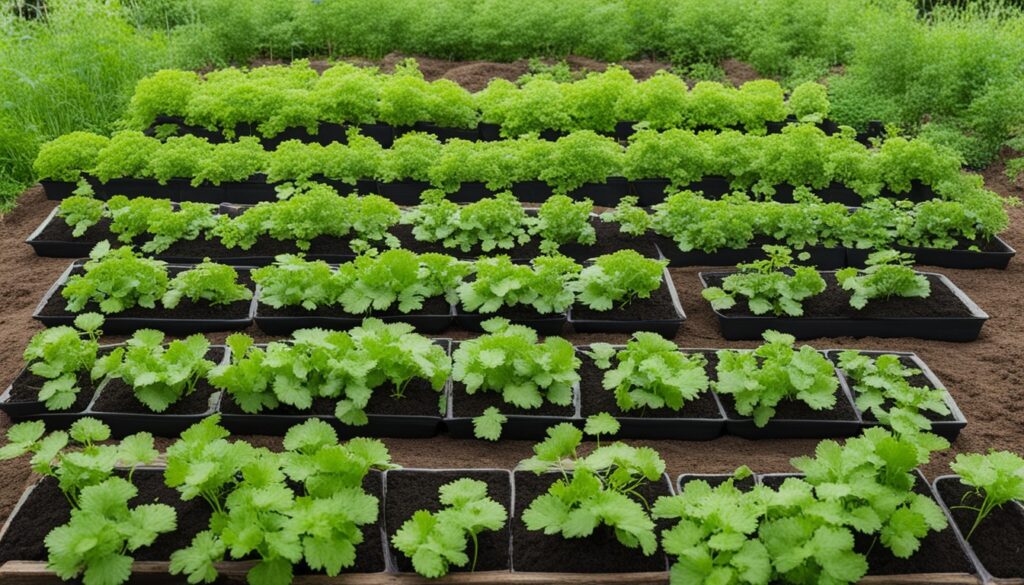
Cilantro Harvesting Tips and Tricks
Growing cilantro can be rewarding, but getting the most from it takes some strategy. Over the years, I’ve discovered a few tricks to keep this herb fresh and plentiful. These tips help extend the life of cilantro and ensure a good harvest.
Harvesting cilantro right is key to keeping it productive. Cut the stems near the ground, taking off only about one-third of the plant. This lets the cilantro regrow and keeps it giving you fresh leaves for your recipes.
Harvesting in the early morning or evening is another smart move. Cilantro loses moisture quickly, so picking leaves during cooler times helps. This keeps the herb’s flavor vibrant.
- Avoid cutting more than one-third of the cilantro leaves at a time to prevent weakening the plant.
- Harvest cilantro leaves in the early morning or evening to minimize moisture loss.
- Cilantro seeds should be harvested as they turn dry and brown.
Cilantro is not just tasty but also packed with nutrients like potassium. It’s best to use it fresh since it doesn’t dry well and loses flavor. Adding chopped cilantro just before cooking brings out the best taste and smell.
By using these cilantro harvesting tips and tricks, you can have a steady supply of this versatile herb. Try different methods to see what suits your garden best. Happy harvesting!
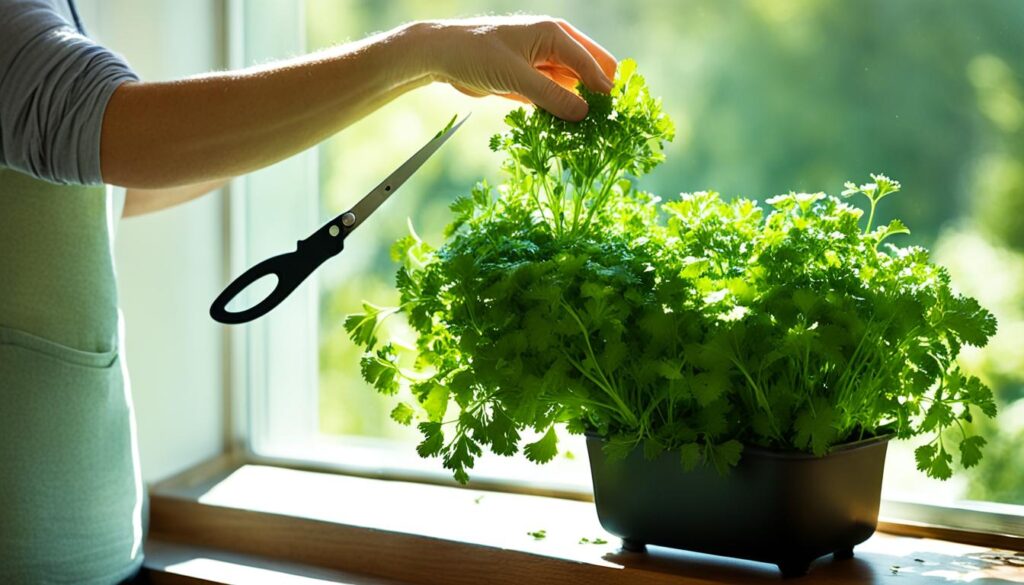
“Freshly chopped cilantro is an excellent source of potassium, is low in calories, and is good for the digestive system.”
| Cilantro Harvesting Best Practices | Benefits |
|---|---|
| Cut only 1/3 of the plant at a time | Allows for regrowth and multiple harvests |
| Harvest in early morning or evening | Minimizes moisture loss and preserves flavor |
| Use fresh cilantro in cooking | Retains maximum aroma and taste |
How To Harvest Cilantro So It Keeps Growing
Getting a lot of cilantro is all about the right timing and methods. With a few easy tips, you can have a steady supply of this tasty herb all season.
Cilantro leaves are ready to pick about 50 to 60 days after you plant them from seeds. Some types get ready even faster, in just one month. The best time to pick them is in the morning, before they start flowering. This is when they taste the best.
When picking, don’t take more than one-third of the plant at once. This keeps the cilantro healthy and growing. Use sharp scissors to cut the stems close to the ground, leaving 2-3 inches of stem. Picking regularly can also stop the plant from flowering too soon, making it last longer.
To keep your cilantro doing well, feed it with a good fertilizer after about 4-5 harvests. Use something like Miracle-Gro® Performance Organics® Edibles Plant Nutrition. This gives the plant the nutrients it needs to keep producing tasty leaves.
With a bit of care and attention, you can have a constant supply of fresh cilantro all season. Just remember to pick wisely, and your cilantro will keep coming back!
Cilantro Seeds and Coriander
Cilantro is a key herb in many dishes. It’s not just the leaves that are useful, but also the seeds, known as coriander. These seeds are a versatile spice for many recipes.
Harvesting Cilantro Seeds
Harvesting cilantro seeds is easy. The plant’s small white flowers turn into round, brown seed heads as it matures. When these seed heads dry and split, it’s time to collect them.
Clip off the seed heads and put them upside down in a paper bag. Let them dry for a few days. The seeds will drop into the bag, ready for use.
Don’t wait too long to harvest the seeds. The stems weaken and the seed heads may fall over. Once collected, store the coriander seeds in a cool, dry place for up to a month. Then, move them to an airtight container for longer storage.
Using Coriander in Cooking
Coriander seeds have a unique flavor. They’re often used in curries, poultry dishes, and pickles. They add a warm, citrusy taste to many dishes.
Using your own cilantro lets you have fresh leaves and coriander seeds. This herb is great for the kitchen garden. It’s versatile and helps reduce waste by using the whole plant.
Conclusion
Cilantro is a great herb that can give you fresh leaves all season if you grow and harvest it right. Knowing what makes it bolt, like temperature and light, helps me keep it fresh. This way, I can enjoy its bright flavor all season.
With the right conditions and planning, cilantro becomes a key part of my garden. It adds a zesty touch to my meals or can be saved for later. This fast-growing herb is a kitchen treasure.
To keep cilantro thriving, I watch for signs of bolting and harvest at the right time. Using shade and mulch also helps it last longer. These simple steps ensure I always have plenty of this tasty, healthy herb.
FAQ
How can I harvest cilantro to keep it growing?
Harvest cilantro’s leaves in the cooler months of spring and fall. You can also harvest through winter in places without hard freezes. Cut the leafy stems near the ground, but take no more than one-third of the leaves at once. This keeps the plant strong.
What factors trigger cilantro to bolt?
Temperature and day length trigger cilantro to bolt. It likes cool to moderate temperatures. When temperatures hit the 70s, it starts to bolt. It also bolts if the day gets longer than 12 hours, focusing on making seeds.
How do I prevent my cilantro from bolting too quickly?
Use techniques like succession planting, shading, or mulching to prevent bolting. These methods keep the roots and soil cooler. This can give you more time before the cilantro bolts.
When is the best time to harvest cilantro seeds?
Harvest cilantro seeds when they turn dry and brown. Cut the seed heads and put them upside down in a paper bag. In a few days, the husks will dry and split, dropping the seeds inside. Harvest quickly to avoid the stems falling over.
How do I use fresh cilantro in cooking?
Use fresh cilantro for its health benefits and great taste. It’s full of potassium, low in calories, and aids digestion. Add chopped leaves right before serving for the best flavor.
